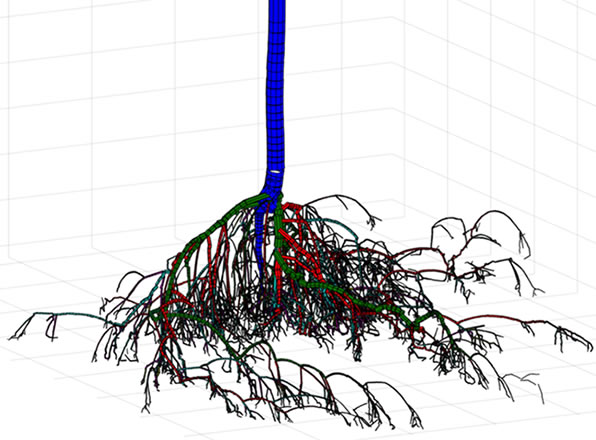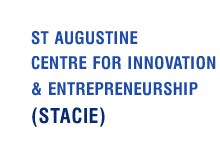
As countries attempt to cut emissions of greenhouse gases to slow climate change, some are turning to trees to remove carbon dioxide from the atmosphere and offset their carbon footprint. To determine how much carbon dioxide that trees remove from the atmosphere, scientists measure the carbon stored, or sequestered, in wood. But when applied to mangroves with complicated prop roots, the method for estimating carbon sequestration has been limited.
Until now.
 M.Sc. Student Tiaron Tiaoti measuring tree diameter using an electronic caliper
M.Sc. Student Tiaron Tiaoti measuring tree diameter using an electronic caliper
UWI researchers have discovered a way to measure the so-called blue carbon stored in mangrove trees with an accuracy never before achieved.
Carbon dioxide is the most commonly produced greenhouse gas that contributes to climate change. Trees remove carbon dioxide from the atmosphere during photosynthesis and store carbon in wood in a process called carbon sequestration. Once those trees aren’t cut down or burned, they continue to remove carbon dioxide from the air. Carbon sequestration is, therefore, a promising method for reducing global climate change and is encouraged in the UNFCC Paris Agreement.
To estimate how much carbon is sequestered in a tree, the standard method calls for you to determine the volume of the tree, convert it to biomass and determine the carbon content in a sample of wood.
 M.Sc. Student Dayeron Mitchell measuring tree height with Hypsometer
M.Sc. Student Dayeron Mitchell measuring tree height with Hypsometer
Scientists measure the tree's diameter at breast height (about 1.3m) and find its height by directing a laser, called a Hypsometer, to the top of a tree. Treating the tree as a cylinder, they then find the volume and calculate the amount of carbon stored in the entire tree.
The problem, of course, is that trees are not perfect cylinders especially when they have prop roots sticking out.
During the previous project to measure carbon sequestration at five locations reforested by the National Gas Company (NGC), Director of STACIE and Professor of Tropical Island Ecology, John Agard, used the standard method for determining carbon content. It was after that project that he thought that measuring carbon sequestration could be done in a new way. “I had this idea, if I could get a ground-based Imaging Laser Scanner, I could put it on different sides of the tree, and I could knit it together. I could get an image of the tree, prop roots and branches, in three dimensions, to scale,” Professor Agard said.
 Prof. Agard with Ph.D. student Hamish Asmath and M.Sc. student Nikia Gooding in the Caroni Swamp
Prof. Agard with Ph.D. student Hamish Asmath and M.Sc. student Nikia Gooding in the Caroni Swamp
Through STACIE, he received funding to test his idea from the British Commonwealth and Foreign Service Office through the British High Commission in Trinidad and Tobago. With the device in hand, Professor Agard took students and staff to measure blue carbon—the term for carbon sequestered in coastal ecosystems—in mangroves in Trinidad and Jamaica.
After three months, the team produced their results.
“I’m hoping it will eventually lead to having a new global standard for how to measure carbon sequestration in mangroves. A more accurate method that many countries can use.”
In the new project in collaboration with the IMA, Professor Agard leads the team of researchers who developed the innovative method for determining carbon sequestration in mangroves. He explained: “If you look at mangrove trees, you see they’re very complicated. What happens when you have tangled prop roots sticking out all over the place? Then your estimate, saying the tree is essentially a cylinder, will turn out to be an underestimation. But what if I could capture all those prop roots in three dimensions, to scale?
And that is exactly what he and his team were able to do.
The innovation uses software developed to create a 3D model of the tree to scale. Other software then strips the leaves from the tree. What you’re left with is a precise scaled image of the aboveground woody, carbon storing, parts of the tree.

More proprietary software then uses the exact dimensions of the tree to calculate its volume including prop roots and the biomass of the above-ground carbon. So instead of treating the tree as a cylinder, the carbon in branches and prop roots can now be measured. This technology, therefore, gives a more accurate measurement of the carbon sequestered in trees and, thus, removed from the atmosphere. The innovation is to use an imaging laser scanner to capture the red mangrove trees including the complicated prop roots shown in 3-Dimensions to scale. Unique software shown below on the prop roots was then used to determine the precise volume and then biomass of the above ground carbon in the prop roots which was not previously possible.
 Software calculates volume of complicated red mangrove prop roots using 3D image
Software calculates volume of complicated red mangrove prop roots using 3D image 3-D reconstruction of Red Mangrove trees in Nariva Swamp using Imaging Laser Scanner
3-D reconstruction of Red Mangrove trees in Nariva Swamp using Imaging Laser Scanner








